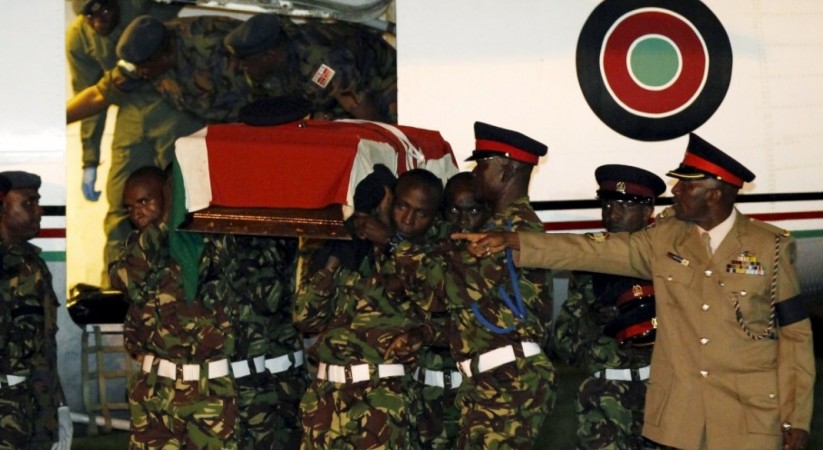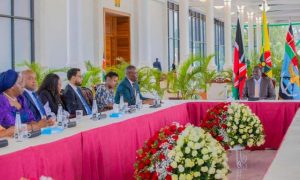
Members of the Kenya Defense Forces in Nairobi carry the casket of a comrade serving in the African Union Mission in Somalia, who was killed during an attack last week by Somalia’s al Shabaab Islamist group. (Thomas Mukoya/ Reuters) |
Washington Post | | On Jan. 15, al-Shabaab’s Saleh Nabhan brigade claimed responsibility for overrunning a forward operating base of the African Union Mission in Somalia (AMISOM) at El Adde in Somalia’s Gedo region, near the border with Kenya. Al-Shabaab claimed that it killed “more than 100” of the company of Kenyan soldiers deployed in El Adde and took additional hostages. It kept silent about its own losses. The Kenyan government and AMISOM acknowledged there were fatalities on both sides but have not provided further details.
Who are the players?
AMISOM is the African Union’s longest running and largest-ever peace support operation. AMISOM was deployed in March 2007 to help protect the Transitional Federal Government in Mogadishu from its opponents, most notably al-Shabaab militants. AMISOM is now mandated to reduce the threat posed by al-Shabaab and assist the Somali government to expand its control throughout Somalia
Al-Shabaab emerged in 2005 as a violent Islamist group intent on enforcing its brand of justice across Somalia. In late 2006, it focused on expelling the Ethiopian forces that had intervened in Somalia and later aligned itself with al-Qa’ida.
Why does this attack matter?
El Adde was the third AMISOM forward operating base that al-Shabaab has overrun in the last seven months. In June 2015, al-Shabaab forces attacked and plundered AMISOM’s base at Leego, killing more than 50 Burundian soldiers and stealing equipment, vehicles and arms. In September, the militants stormed AMISOM’s base at Janaale, killing 19 Ugandan soldiers and taking others hostage.
If Kenya did indeed lose more than 100 soldiers last week, the attack on El Adde represents AMISOM’s bloodiest day since it deployed to Mogadishu in March 2007. Regardless of how many died, however, the attack highlights some important lessons for AMISOM and its international partners.
What are the lessons?
1. The threat from al-Shabaab has changed, and its ambitions have expanded
Al-Shabaab no longer poses the existential threat to Somalia’s governing authorities in Mogadishu that it once did, in its “golden age” during 2009-10, when it controlled not only most of the capital city but also most of south-central Somalia. Most of al-Shabaab’s fighters were forced out of Mogadishu in August 2011; today they do not directly govern nearly as many towns across south-central Somalia. But al-Shabaab’s fighters can still move freely, and exert influence over local populations across much of south-central Somalia.
Since mid-2013, al-Shabaab has become an increasingly extremist and transnational network with the stated aim of creating a caliphate across east Africa. It has therefore dramatically increased its recruitment and activities in Kenya. Since then, al-Shabaab has fought to destabilize parts of Kenya – to take back what it claims are Muslim lands – and south-central Somalia in order to undermine AMISOM, reveal the weaknesses of Somalia’s central government and its collusion with foreign forces, and control local populations.
In 2014 and 2015 in Somalia, AMISOM, the Somali National Army (SNA), and supporting militia launched a series of offensives and forced al-Shabaab out of about two dozen towns, as I’ll discuss more below. Some al-Shabaab fighters moved north into the Puntland region while others concentrated in the Jubba River Valley in southern Somalia; from there, they continue to launch attacks.
Al-Shabaab continues to attack the region using a range of military tactics. It has carried out suicide and remotely detonated bombings and commando raids on symbolic government and international targets in Somalia’s capital, Mogadishu. It has frequently harassed AMISOM and SNA supply routes.
Its two major battalions – the Saleh Nabhan brigade and the Abu Zubair battalion, both named after al-Shabaab commanders who died in battle – have launched major attacks on the three AMISOM bases noted above: in Leego, Janaale and El Adde. In each case, al-Shabaab used large vehicle-borne improvised explosive devices to breach the base before invading with several hundred infantry.
2. AMISOM forces remain vulnerable, even as the war against al-Shabaab has changed
Because Al-Shabaab can usually avoid AMISOM and SNA forces, it attacks the African Union peacekeepers when and where it wants. The El Adde battle is just the latest reminder of how vulnerable AMISOM’s forces are.
Over the past nine years, AMISOM’s war against al-Shabaab has evolved from urban warfare in Mogadishu to a sprawling counterinsurgency and stabilization campaign waged across most of south-central Somalia. In late 2013 the United Nations Security Council authorized a “surge” of over 4,000 additional troops for AMISOM, most of which came from Ethiopia.
In March 2014, AMISOM launched four interrelated operations to degrade al-Shabaab: Operations Eagle, Indian Ocean, Ocean Build and Jubba Corridor. As mentioned above, these forced al-Shabaab’s fighters out of about two dozen towns across south-central Somalia.
But here’s the catch: Because al-Shabaab forces generally retreated without a fight, AMISOM couldn’t deal a fatal blow to the militants’ main combat forces. AMISOM chose to maintain garrisons and forward operating bases across most of these newly recovered settlements — which extended the mission’s supply routes and stretched its forces.
Now AMISOM faces a shortage of needed specialist military units including engineers, logisticians, and aviation assets. For instance, in 2012 the UN Security Council authorized twelve military helicopters, which have never been delivered or deployed, leaving AMISOM with no helicopters. That means AMISOM can’t strike back quickly when al-Shabaab attacks its supply routes and remote forward operating bases.
Meanwhile, AMISOM’s Kenyan forces have failed to build strong relationships with the Gedo region’s local population or SNA forces stationed nearby. That’s what left AMISOM’s forces blind and vulnerable to this most recent attack.
3. The propaganda war between al-Shabaab and Somalia’s government continues
The battle at El Adde has also highlighted the ongoing propaganda war waged by both al-Shabaab and AMISOM and its partners. Each side usually presents very different versions of events.
AMISOM and its contributing governments usually release few details about battles if they’ve lost many troops; its international partners usually offer stock condemnations of al-Shabaab “terrorism.”
Al-Shabaab, in contrast, often quickly releases verbose and usually hyperbolic statements and photographs about its victories, sometimes even while still attacking.
During the two most recent attacks on the AMISOM bases at Leego and Janaale, al-Shabaab later released detailed propaganda videos depicting the battles and their aftermath. These have revealed far more information about these episodes than the information provided by the African Union — and have emboldened al-Shabaab’s supporters.
Unlike some other African Union peace operations, AMISOM’s policy is to not release information about its fatalities; it leaves that decision to the respective contributing country. But these countries usually refuse to issue full details, fueling estimates of AMISOM’s fatalities that vary wildly.
As a result, the subject of AMISOM’s fatalities has become very controversial for both the families of the dead soldiers and for its international partners. For the families, information about their relatives in uniform is not always forthcoming. Meanwhile international partners are asked to foot the bill for death and disability compensation payments without accurate information about those deaths.
The Memorandums of Understanding signed between the African Union and the AMISOM contributing countries stipulate that families of deceased soldiers should receive compensation of US$50,000. These payments are made with money donated to the African Union by the European Union, through its African Peace Facility. That makes it important for the families of the deceased, the international partners who pay the compensation, and the African Union to publicly recognize all AMISOM’s fallen peacekeepers. Having accurate information would also help counteract al-Shabaab’s propaganda.
What should Somalia and its allies do now?
The El Adde attack leaves AMISOM and its international partners with some difficult choices. How can they best reduce the threat posed by al-Shabaab? How can the African Union and SNA forces on the front lines be better protected? Finally, if AMISOM’s contributing countries do not reveal the facts about these attacks, al-Shabaab’s propaganda will continue unchecked.
.
Paul D. Williams is associate professor in the Elliott School of International Affairs at George Washington University. He is the author of War and Conflict in Africa and can be found on Twitter @PDWilliamsGWU.
___________________________
_____________________________________________________________________________________
Xafiiska Wararka Qaranimo Online | Mogadishu, Somalia
_____________________________________________________________________________________Advertisement
_____________________________________________________________________________________







